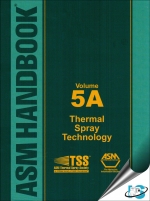This new addition to the ASM Handbook series is co-published by the Thermal Spray Society and ASM International. Volume 5A is a replacement for the Handbook of Thermal Spray Technology, edited by J.R. Davis (ASM, 2004). The volume provides an introduction to modern thermal spray processes including plasma spray, high velocity oxy-fuel, and detonation gun deposition; and a description of coating properties, their wear, corrosion, and thermal barrier characteristics. Principles, types of coatings, applications, performance, and testing/analysis also are covered. The Handbook serves as an excellent introduction and guidebook for those new to thermal spray.
A greatly expanded selection of applications includes examples and figures from various industries, including electronics and semiconductors, automotive, energy, and biomedical. Emergent thermal spray market sectors such as aerospace and industrial gas turbines, and important areas of growth such as advanced thermal barrier materials, wear coatings, clearance control coatings, and oxidation/hot corrosion resistant alloys also are reviewed.
Thermal spray coatings offer industry the opportunity to improve the performance and lower the costs of manufacturing equipment and processes as well as products produced. The major advantages of thermal spray processes include the ability to produce coatings of an extremely wide variety of materials (including ceramics, metals, cermets, and some polymerics), to deposit those materials without significantly heating the substrate and thus without changing the dimensions or properties of the component being coated, and, in most cases, to strip a worn coating and replace it with a new one.
More reliable and robust equipment technology, along with improved particle diagnostics, have helped to move the thermal spray process from guesswork to science, giving designers and end users more confidence in the long-term manufacturing capabilities of thermal spray processes. The key to future growth will be environmental barrier coatings for applications using high temperature composite substrates that surpass the operating limits of superalloys and advanced high temperature ceramics for insulation purposes.
Preface
Policy on Units of Measure
List of Contributors
Part I : Introduction to Thermal Spray Technology and Surface Engineering
Chapter 1 : Introduction to Thermal Spray Technology
Chapter 2 : Surface Engineering
Part II : Thermal Spray Processes and Coatings
Chapter 3 : Thermal Spray Processes
Chapter 4 : Cold Spray Process
Chapter 5 : Coating Structures, Properties, and Materials
Chapter 6 : Process Control and Control Equipment
Chapter 7 : Introduction to Coating Design and Processing
Chapter 8 : Process Modeling
Part III : Consumables
Chapter 9 : Feedstock Material Considerations for Thermal Spray
Part IV : Precoating and Postcoating Processing
Chapter 10 : Precoating Operations
Chapter 11 : Postcoating Operations
Part V : Health and Safety
Chapter 12 : Health and Safety
Chapter 13 : Guidelines for the Use of Personal Protective Equipment in Thermal Spraying
Chapter 14 : Safety Guidelines for Performing Risk Assessments
Chapter 15 : Safety Guidelines for the Handling and Use of Gases in Thermal Spraying
Chapter 16 : Thermal Spray Booth Design Guidelines
Part VI : Testing and Characterization
Chapter 17 : Introduction to Testing and Characterization
Chapter 18 : Metallography and Image Analysis
Chapter 19 : Testing of Coatings
Chapter 20 : Powder Testing and Characterization
Part VII : Existing and New Market Opportunities in Thermal Spray Applications
Chapter 21 : Introduction to Applications for Thermal Spray Processing
Chapter 22 : Corrosion Control for Marine- and Land-Based Infrastructure Applications
Chapter 23 : Wear-Resistant Coatings
Chapter 24 : Corrosion and Wear Control for Industrial Applications
Chapter 25 : Thermal Spray Coatings for Electrical and Electronic Applications
Chapter 26 : Thermal and Environmental Barrier Coatings (TBCs/EBCs) for Turbine Engines
Chapter 27 : Thermal Spray Technology Growth in Gas Turbine Applications
Chapter 28 : Abradable Thermal Spray Applications and Technology
Chapter 29 : Replacement for Hard Chrome Plating on Aircraft Landing Gear
Chapter 30 : Automotive Coatings and Applications
Chapter 31 : Biomedical Coatings Made by Thermal Spraying for Orthopaedia Joint Applications
Chapter 32 : Protective Overlays and Coatings Used in Oil Sands
Chapter 33 : Renewable Energy Applications
Chapter 34 : Nuclear Industry Applications for Thermal Spray
Chapter 35 : Thermal Spray Applications in the Steel Industry
Chapter 36 : Thermal Spray Applications in the Paper Production Industry
Chapter 37 : Printing Industry Applications
Chapter 38 : Additional Applications in Thermal Spray
Chapter 39 : Appendix - Key ITSC Papers in Thermal Spray Applications
Part VIII : Reference Information
Chapter 40 : Guide to General Information Sources
Chapter 41 : A Brief History of the Development of Thermal Spray Processes and Materials
Glossary of Terms
Abbreviations and Acronyms
Index

























